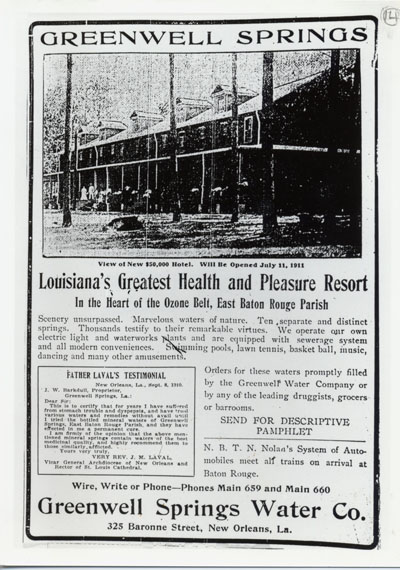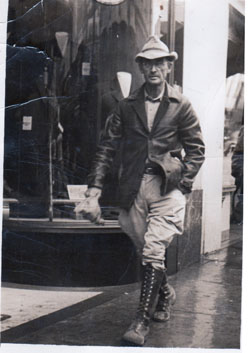Community
Samuel Lee Robinson: A Legacy

 By Vicki Carney
By Vicki Carney
History is like putting together a large, complicated puzzle. Everyone is a piece of that puzzle and each piece has to match correctly on each side to complete the puzzle. Samuel Lee Robinson was one of these puzzle pieces and it was so exciting to put this piece in its rightful place.
Samuel Lee Robinson left his family a legacy before he died and he probably did not know the significance of what he had done. There are very few relics that exist today of the 1910 Greenwell Springs Hotel and Spa and the Greenwell Springs Watering Company. One relic belongs to the family of the late Dr. Jesse Fairchild, Jr. It was a bottle that he had found that came from the water company. Samuel Lee Robinson saved two very large, heavy relics from the hotel: A Set of Concrete Lamp Posts from the second hotel which was built in 1909 or 1910! You see, Sammie Lee worked in the engine room and maintenance department of the bottling company until the first few years of state ownership. (Jesse Lee Fairchild, Jr., A Historical Sketch of Greenwell Springs). During this time he and his sons would clean each of the openings of the ten springs and even scrub the walls every Saturday morning. He was also manager and caretaker and gave dances and picnics at the old hotel. The late Bob Baker wrote this description in April 30, 1986 for the Central News (this newspaper no longer exists):
“When I first remember Greenwell Springs, Mr. Sammie Lee Robinson lived on the property as manager and caretaker and gave dances and picnics at the old hotel. The porch was about 20 feet wide and ran all the way around the main building. Toot Johnson’s black band out of Baton Rouge furnished the music. Before the old hotel burned around 1926 and 1927 (Dr. Fairchild wrote that it was actually December 23, 1922 due to a fire caused by a heater), Clara Bow and the Flapper Girls were in style, people were dancing the Charleston, the big boys were wearing white linen suits, hard straw hats and drinking white lighting out of fruit jars. Prohibition was on and bootlegging was in.”
Now, let’s go back to those very heavy lamp posts. Sammie Lee was able to transport two of the lamp posts to his property on Greenwell Springs Road. Many of you have probably passed one lamp post many times going north on Greenwell Springs Road and thought it was a tree! It is located on the west side where there is a Camellia Acres sign, one-half mile from the Greenwell Springs Post Office. There is another lamp post lying on its side on the property of Sharon Robinson Phares, granddaughter of Samuel Lee Robinson. How wonderful to know that a piece of the Greenwell Springs Hotel still exists today and it can be seen by anyone driving down the road!
Another side of Mr. Sammie Lee’s puzzle piece would be the old Natalbany Lumber Crossing of 1926. This railroad existed to haul timber in Central and the path of the spur can clearly be seen on Sharon Robinson Phares’ property. She even possesses some spikes from the old railroad that she found on her property. This railroad went from her property over a railroad bridge crossing the Amite River into Livingston Parish. The late Bob Baker wrote that he was 13 at that time and talked his dad into letting him drop out of school for half a year to help his dad make cross ties for the railroad.
There was a big political debate going on in 1953 about the railroad bridge. (Plainsman, December 31, 1953). Citizens of Livingston Parish and East Baton Rouge Parish were deciding the question of where a new bridge across the Amite River would be placed. Many people in Livingston Parish wanted the bridge to be built at the Natalbany Lumber Crossing which would connect East Baton Rouge Parish to Watson. Others wanted to keep the bridge at the present site of Magnolia Bridge. Sharon said that her father Ernest Volida Robinson worked hard to get the Natalbany Lumber Crossing location. It was called the old Kemp crossing which was commonly known as the Watson location. The new Amite River Bridge was finally built in the location of the old Magnolia Bridge. It’s amazing how this decision changed the land use plan for both areas.
A third side of this puzzle piece is Samuel Lee Robinson and his wonderful family, many of whom still live on his property. Sharon writes this about her grandfather:
“My grandfather attended Zoar Baptist Church. Brother Hopper held a tent meeting at Grandpa’s after his stroke, so he could attend. It was a very small tent with wooden benches. Our family attended. How generous of Brother to do that for grandpa. Grandpa enjoyed playing with his grandchildren, reaching out with his walking stick to catch us as we walked or ran by.”
Samuel Lee Robinson was born in Magnolia, Louisiana (the historic community on the Central side of Magnolia Bridge). He was born on October 26, 1887 and died September 26, 1948. He married Susan Ernestine Lee in 1908. Susan was born in Indian Mound, Louisiana, (the historic community just north of Magnolia). She was born January 25, 1889 and died March 4, 1964. They had eight children. Their second son, Ernest Volida Robinson, was Sharon’s father.
Pictured, Top: An ad for the Greenwell Springs Resort and Spa. Bottom: Samuel Lee Robinson


1 Comment